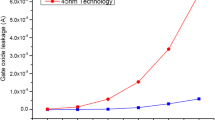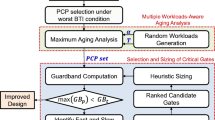Abstract
The integrated circuit industry not only demands finding optimal design solutions over an efficient process, but also requires the address of increased reliability challenges, caused by strong electric fields, to elevate the overall system robustness. This work reconciles such an inconsistency by proposing a transistor-level methodology for current steering DACs to map their specs onto transistor sizes and improve their performance, parametric yield as well as lifetime reliability through the state of the art evolutionary tools and reliability simulator. The tradeoff between performance specs and power consumption is obtained through a multi-objective approach by considering process variations together with lifetime stress effects. The 10-bit DAC@130MS/s is herein implemented using TSMC CMOS 0.18 μm technology. Demonstrated results point out optimal design points in short and long time reliability as well as performance parameters over a computational effective procedure.













Similar content being viewed by others
References
Sahoo, B., & Razavi, B. (2013). A 10-b 1-GHz 33-mW CMOS ADC. IEEE Journal Solid-State Circuits, 48(6), 2366–2380.
Mafi, H., Yavari, M., & Shamsi, H. (2016). Digital calibration of DAC unit elements mismatch in pipelined ADCs. IEEE Trans Circuits and Systems I: Regular Papers, 63(1), 34–45.
Mirzaie, N., Shamsi, H., & Byun, G. S. (2017). Automatic design and yield enhancement of data converters. Journal of Circuits, Systems and Computers. doi:10.1142/S0218126617500189.
Blish, R., et al. (2003). Critical reliability challenges for the international technology roadmap for semiconductors (ITRS). Technology Transfer.
Gielen, G., et al. (2008). Emerging yield and reliability challenges in nanometer CMOS technologies. In Proc. design, automation and test in Europe (pp. 1322–1327).
Fakhfakh, M., et al. (2015). Computational intelligence in analog and mixed-signal (AMS) and radio-frequency (RF) circuit design. Switzerland: Springer.
Ma, M., Hedrich, L., & Sporrer, Ch. (2014). ASDeX: A formal specification for analog circuit enabling a full automated design validation. Design automation for embedded systems. New york: Springer, 18 (1), pp. 99–118.
Mirzaie, N., Seyyed Mahdavi, S. J., & Mohammadi, K. (2010). Evolving more testable digital combinational circuit. In Proceedings of IEEE International Conference on Computer Design.
Milor, L. (2013). A survey of yield modeling and yield enhancement methods. IEEE Transactions on Semiconductor Manufacturing, 26(2), 196–213.
McConaghy, T., & Gielen, G. G. (2009). Globally reliable variation-aware sizing of analog integrated circuits via response surfaces and structural homotopy. IEEE Transaction on Computer-Aided Design of Integrated Circuits and Systems, 28(11), 1627–1640.
Kuo, W., Chien, W. T. K., & Kim, T. (2013). Reliability, yield, and stress burn-in. Berlin: Springer Science & Business Media.
Schroder, D. K., et al. (2003). Negative bias temperature instability: Road to cross in deep submicron silicon semiconductor manufacturing. Journal of Applied Physics, 94(1), 1–18.
La Rosa, G., Rauch, S, & Guarin F. (2001). New phenomena in device reliability physics of advanced CMOS submicron technologies. In Proc. IEEE IRPS Tutorial.
Stathis, J. H. (2001). Physical and predictive models of ultrathin oxide reliability in CMOS devices and circuits. IEEE Transaction Device and Materials Reliablity, 1(1), 43–59.
Nigam, T. (2008). Pulse-stress dependence of NBTI degradation and its impact on circuits. IEEE Transaction Device and Materials Reliablity, 8(1), 72–78.
Pan, X., & Graeb, H. (2011). Lifetime yield optimization of analog circuits considering process variations and parameter degradations. In Advances in analog circuits (pp. 56–99).
Kufluoglu, H., & Alam, M. (2004). A geometrical unification of the theories of NBTI and HCI time-exponents and its implications for ultra-scaled planar and surround-gate MOSFETs, IEDM.
Estrada, D., Ogas, M. L., Southwick, R. G., Price, P. M., Baker, R. J., & Knowlton, W. B. (2008). Impact of single pMOSFET dielectric degradation on NAND circuit performance. Microelectronics Reliability, 48(3), 354–363.
Tu, R. H., Rosenbaum, E., Chan, W. Y., Li, C. C., Minami, E., Quader, K., et al. (1993). Berkeley reliability tools—BERT. IEEE Transaction on Computer-Aided Design Integrated Circuits Systems, 12(10), 1524–1534.
Salemi, S., Yang, L., Dai, J., Qin, J., & Bernstein, J. B. (2008). Physics-of-failure based handbook of microelectronic systems. Utica, NY: RIAC, p. 12. 221–225.
Liu, B., Fernandez, F. V., & Gielen, G. G. E. (2011). Efficient and accurate statistical analog yield optimization and variation-aware circuit sizing based on computational intelligence techniques. IEEE Transactions on Computer-Aided Design of Integrated Circuits and Systemsvol, 30(6), 793–805.
Mac, P., et al. (2014). Enhancing the performances of recycling folded cascode opamp in nanoscale CMOS through voltage supply doubling and design for reliability. International Journal of Circuit Theory and Applications, 42(6), 605–619.
Jung, S., Lee, J., & Kim, J. (2014). Yield-aware pareto front extraction for discrete hierarchical optimization of analog circuits. IEEE Transaction on Computer-Aided Design of Integrated Circuits and Systems, 33(10), 1437–1449.
Price, K., Storn, R., & Lampinen, J. (2006). Differential evolution, a practical approach to global optimization. Newyork: Springer.
Goldberg, D. (1989). Genetic algorithms in search, optimization and machine learning. Boston, MA: Addison-Wesley.
Kuo, C. C., et al. (2012).Efficient trimmed-sample Monte Carlo methodology and yield-aware design flow for analog circuits. In Proceedings of DAC, pp. 1113–1118.
Stein, M. (1987). Large sample properties of simulations using latin hypercube sampling. Technometrics, 29(2), 143–151.
Chen, Y., et al. (2015). Incremental Latin hypercube sampling for lifetime stochastic behavioral modeling of analog circuits. In Proceedings of ASP-DAC.
Tian, W., Ling, X., & Liu, R. (1996). Novel methods for circuit worst-case tolerance analysis. IEEE Transactions on Circuits and Systems I: Fundamental Theory and Applications, 43(4), 272–278.
Price, K., Storn, R., & Lampinen, J. (2005). differential evolution, a practical approach to global optimization. Berlin: Springer.
Yu, G., & Li, P. (2011). Hierarchical analog/mixed-signal circuit optimization under process variations and tuning. IEEE Transaction Computer-Aided Design of Integrated Circuits and Systems, 30(2), 313–317.
McConaghy, T. (2008). “Variation-aware structural synthesis and knowledge extraction of analog circuits,” Ph.D. dissertation, ESAT-MICAS, Katholieke University, Leuven, Belgium.
Graeb, H. (2007). Analog design centering and sizing. Berlin: Springer.
Hu, C., et al. (1985). Hot-electron-induced MOSFET degradation—model, monitor and improvement. IEEE Transaction on Electron Devices, 32(2), 375–385.
Mercer, D., & Schofield, W. (2004). Digital/analog converter including gain control for a sub-digital/analog converter, U.S. Patent 6,738,006.
Kester, W. A., et al. (2005). Data conversion handbook, Newnes.
Liu, B., Fernandez, F. V., & Gielen, G. (2014). Automated design of analog and high frequency circuits. A computational intelligence approach. Germany: Springer.
Cho, H. H., Park, C. Y., Yune, G. S., Yoon, & K. S. (2004). A 10-bit 210 MHz CMOS D/A converter for WLAN. In IEEE International Conference Asia-Pacific on advanced system integrated circuit (pp. 106–109).
Sullivan, K. O., Gorman, C., Hennessy, M., & Callaghan, V. (2004). A 12-bit 320-MSample/s current-steering CMOS D/A converter in 0.44 mm2. IEEE Journal Solid-State Circuits, 39(7), 1067–1072.
Halder, S., et al. (2005). A 10-bit 80-MSPS 2.5-V 27.65-mW 0.185-mm2 segmented current steering CMOS DAC, International Conference on VLSI Design, pp. 319–22.
Ieong, K. H. A., Seng-Pan, U., & Martins, R. P. (2006). A 1-V 2.5-mW transient-improved current-steering DAC using charge-removal-replacement technique, IEEE International Conference on Asia-Pacific on circuits and system, pp. 183–6.
Hong, G., et al. (2008). A 10-bit 300 MHz0.1 mm2triple-channel current-steering DAC 75.98 dB SFDR in 65 nm, IEEE International Conference on VLSI-DAT, Automation and Test, pp. 148–151.
Author information
Authors and Affiliations
Corresponding author
Rights and permissions
About this article
Cite this article
Mirzaie, N., Shamsi, H. & Byun, GS. Resilient design of current steering DACs using a transistor level approach. Analog Integr Circ Sig Process 90, 29–41 (2017). https://doi.org/10.1007/s10470-016-0859-1
Received:
Revised:
Accepted:
Published:
Issue Date:
DOI: https://doi.org/10.1007/s10470-016-0859-1




